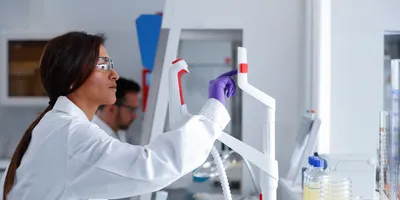It’s exciting when a lab transitions from research to development, and eventually to clinical trials and production. However, the transition is rarely seamless. Equipment that performed well in basic or applied research may not be able to handle the demands that come with regulatory scrutiny in preparation for production. This results in delayed timelines, frustrated teams, and equipment adjustments or replacement, all of which add up to significant cost increases.
All of this can be avoided with the right preparation and adherence to Good Manufacturing Practice (GMP) guidelines. GMP guidelines are designed to maintain product safety, efficacy, and quality, particularly in the pharma and biotech industries.
The challenges labs face in this shift to production emphasize why ` is essential for maintaining quality and safety. Consistency and quality require attention to crucial elements like fully validating equipment and procedures, maintaining clear and thorough documentation, and ensuring proper training. One way to help ensure quality and performance of process equipment is with a strong relationship between internal technical teams and equipment manufacturers.
Common challenges in implementation
Transitioning equipment from research use to production under GMP can reveal unexpected performance issues. For example, equipment that worked well enough during the research phase may struggle to meet the demands of a GMP environment. Incubators or freezers that seemed reliable may exhibit uneven temperature recovery or inconsistent air circulation when scaled to production volumes, leading to inefficiencies, poor performance, and reduced therapeutic quality.
Even with successful installation and operational qualifications (IQ/OQ), unforeseen issues often arise. Poor sensor placement or variation in air circulation may reveal uneven temperature profiles or poor performance, such that cell cultures spend little time at their specified conditions needed for proper growth. Replacement and requalification can thus impact timelines for clinical trials and production.
In a GMP setting, thorough documentation is essential. Equipment should come with certificates of conformity and factory acceptance tests to avoid more delays in obtaining the documentation needed for audits and regulatory reviews. Without proper documentation, even the best equipment can become a liability, slowing down processes and jeopardizing compliance.
While these common challenges in implementation can happen, they don’t have to derail your progress toward a GMP-compliant environment. Projects can be kept on track by evaluating equipment performance early, fine-tuning qualification processes, and guaranteeing that proper documentation is in place.
Building strategic partnerships for lasting success
Start by getting your equipment manufacturer involved as early as possible so they can help guide you when critical questions come up about a product’s specs or how the equipment will perform in a GMP setting. They can also help ensure that you’re asking the right questions to confirm that the equipment is the best fit for your needs.
Compatibility is also important to consider. A production suite may have existing infrastructure. Involving your IT team early can help integrate monitoring and alarm systems and prevent compatibility issues during implementation. This proactive step helps allow for a seamless process for scaling up or introducing new technologies.
Your manufacturer representative brings a wealth of information that you can draw upon to your advantage. Partnering with knowledgeable representatives from the manufacturer—not just a distributor—provides access to specialized expertise that simplifies troubleshooting and streamlines qualification processes. Collaborating with your manufacturer and maintaining a strong working relationship saves time and resources, ultimately leading to smoother transitions and minimizing the risk of costly setbacks.
Lab Quality Management Certificate
The Lab Quality Management certificate is more than training—it’s a professional advantage.
Gain critical skills and IACET-approved CEUs that make a measurable difference.
These relationships are strategic, practical, and essential. When things feel uncertain, solid manufacturer relationships and strategic collaborations help keep you on track and set you up for continued success.
Fostering compliance and preparing for the future
Fostering compliance starts at the top. Leadership always sets the tone for GMP compliance, and this is done through fostering a culture that prioritizes it. By prioritizing compliance at all levels, organizations can establish a culture of accountability and excellence.
One way to foster a strong culture of compliance is by empowering staff to take ownership of their roles. Encouraging employees to identify and report potential issues not only helps prevent small problems from escalating but also creates a sense of accountability and shared responsibility across the team. When staff feel confident that their observations and concerns are valued, they are more likely to stay vigilant and actively uphold GMP compliance in their daily work.
Secondly, leadership plays a critical role in ensuring that vigilance remains a priority by providing ongoing training opportunities. Regular training sessions keep teams informed about the latest process requirements, industry best practices, and potential pitfalls. This continuous education reinforces the importance of compliance and equips employees with the knowledge and tools they need to adapt to changes in regulations and technology. Additionally, tailored training programs that address specific roles and responsibilities within the facility can make compliance efforts more effective and actionable for every team member.
Once a culture of compliance is established, institutions can further enhance their efforts through automation. Automation reduces manual errors, increases efficiency, and enables real-time compliance monitoring, making it an invaluable tool for maintaining high standards in a rapidly changing environment.
Labs that cultivate a culture of accountability, remain flexible, and balance innovation with compliance are better positioned to adapt to evolving regulatory landscapes and meet the rigorous demands of GMP compliance.
Building a resilient, GMP-ready operation
GMP compliance forms the foundation of quality and reliability in a production setting. By proactively addressing challenges, building strong partnerships, and fostering a culture of accountability, biopharma institutions can achieve seamless operations and deliver products that meet the highest standards of safety and excellence.
This balance of compliance with innovation positions teams to adapt when regulatory standards continue to evolve. GMP principles enable every production setting to meet the highest safety and quality standards, protecting both patients and the company’s reputation in a high-stakes industry.












